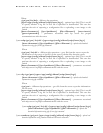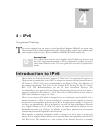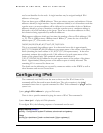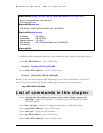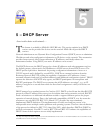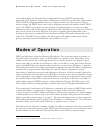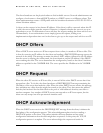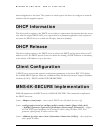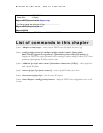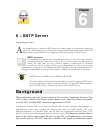
77
5 – DHCP Server
Access to other devices on the network….
his feature is available in MNS-6K-SECURE only. This section explains how DHCP
services can be provided for devices on the network. MNS-6K can provide DHCP
services.
Network administrators use Dynamic Host Configuration Protocol (DHCP) servers to administer
IP addresses and other configuration information to IP devices on the network. This automation
provides better control, allows better utilization of IP addresses and finally reduces the
maintenance burden. Using DHCP, non active IP address can be reused.
The DHCP client uses the DHCP protocol to obtain IP addresses and other parameters such as
the default gateway, subnet mask, and IP addresses of DNS servers from a DHCP server. The
DHCP protocol provides a framework for passing configuration information to hosts on a
TCP/IP network and is defined by several RFCs. DHCP was a natural evolution from the
Bootstrap Protocol (BOOTP), adding the capability of expiration of IP addresses (a lease),
automatic allocation and reuse of network addresses and additional configuration options. DHCP
captures the behavior of BOOTP relay agents, and DHCP participants can interoperate with
BOOTP participants. The DHCP server ensures that all IP addresses are unique
4
, e.g., no IP
address is assigned to a second client while the first client's assignment is valid (its lease has not
expired).
DHCP emerged as a standard protocol in October 1993. DHCP evolved form the older BOOTP
protocols, where IP address leases were given for infinite time and as networks evolved, BOOTP
faced a restriction as to additional information needed to support different options for proper
operation of network devices. Due to the backward compatibility of DHCP, very few networks
continue to use only BOOTP. RFC 2131 (March 1997) provides the most commonly
implemented DHCP definition. This implementation is widely used and has proven to be
interoperable across multiple vendor platforms and operating systems. There are other definitions
of the protocol as defined in RFC 3315 (dated July 2003), which describes DHCPv6 (DHCP in
an IPv6 environment). New RFC’s such as RFC 3396 and RFC 4391 enhance the capabilities of
DHCP. Some of these options are not widely implemented.
4
To keep the unique IP address assignment, network administrators must ensure no manual IP addresses are set and there is only
one DHCP server on the network (or on a VLAN.)
Chapter
5
T



